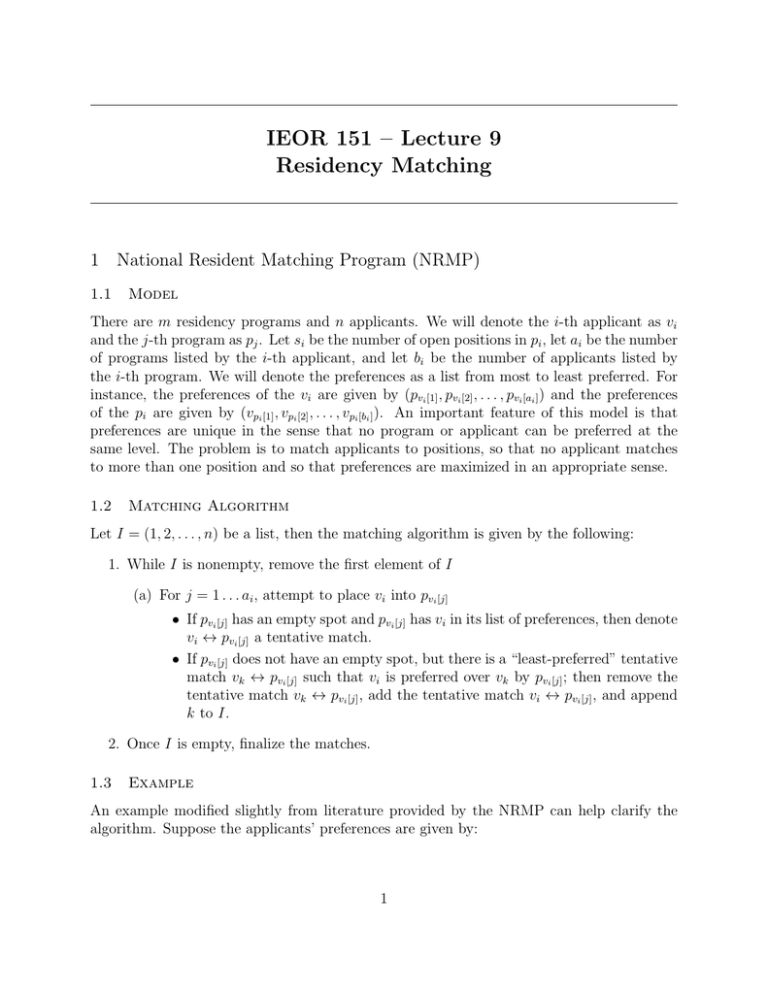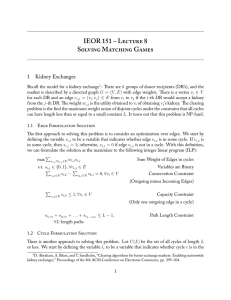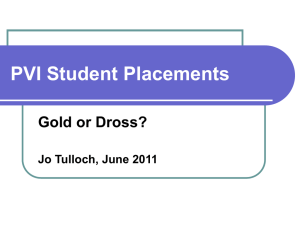IEOR 151 – Lecture 9 Residency Matching 1 National Resident Matching Program (NRMP)
advertisement

IEOR 151 – Lecture 9 Residency Matching 1 National Resident Matching Program (NRMP) 1.1 Model There are m residency programs and n applicants. We will denote the i-th applicant as vi and the j-th program as pj . Let si be the number of open positions in pi , let ai be the number of programs listed by the i-th applicant, and let bi be the number of applicants listed by the i-th program. We will denote the preferences as a list from most to least preferred. For instance, the preferences of the vi are given by (pvi [1] , pvi [2] , . . . , pvi [ai ] ) and the preferences of the pi are given by (vpi [1] , vpi [2] , . . . , vpi [bi ] ). An important feature of this model is that preferences are unique in the sense that no program or applicant can be preferred at the same level. The problem is to match applicants to positions, so that no applicant matches to more than one position and so that preferences are maximized in an appropriate sense. 1.2 Matching Algorithm Let I = (1, 2, . . . , n) be a list, then the matching algorithm is given by the following: 1. While I is nonempty, remove the first element of I (a) For j = 1 . . . ai , attempt to place vi into pvi [j] • If pvi [j] has an empty spot and pvi [j] has vi in its list of preferences, then denote vi ↔ pvi [j] a tentative match. • If pvi [j] does not have an empty spot, but there is a “least-preferred” tentative match vk ↔ pvi [j] such that vi is preferred over vk by pvi [j] ; then remove the tentative match vk ↔ pvi [j] , add the tentative match vi ↔ pvi [j] , and append k to I. 2. Once I is empty, finalize the matches. 1.3 Example An example modified slightly from literature provided by the NRMP can help clarify the algorithm. Suppose the applicants’ preferences are given by: 1 Anderson 1. General 2. City Chen 1. City 2. Mercy Davis 1. City 2. General 3. Mercy Eastman 1. City 2. Mercy 3. General Ford 1. City 2. General 3. Mercy Suppose that each program only has two open positions, and that the preferences of the programs are given by Mercy 1. Davis 2. Ford City 1. Anderson 2. Chen 3. Eastman 4. Davis 5. Ford General 1. Eastman 2. Davis 3. Anderson 4. Chen Then the final match results are given by Mercy Ford 1.4 City Chen Davis Eastman General Anderson Davis Game-Theoretic Considerations The first thing to note is that this algorithm generates a stable matching. The intuition for why this is the case is that the algorithm tries to first match to more preferred programs/residents. The second thing to note is that this algorithm is strategy-proof for the residents, under the assumption that residents do not collude. This means that the best game-theoretic strategy for a resident is to submit their true preference list of residency programs. The intuition is again because the algorithm tries to match more preferred elements. 1.5 Optimality It is important to note that the algorithm is not symmetric with respect to the roles of residencies and residents. For comparison, suppose we were to change the algorithm so that we switch the role of the hospitals and residents. Then, the resulting matching would be: Mercy Davis Ford City Anderson Chen General Eastman Davis Compare this matching to the previous result: In the previous result, the residents achieved higher preferences; in this result, the hospitals achieved higher preferences. The 2 general result is that the group that proposes a match will achieve higher preferences than the group that accepts a match. Because the NRMP is structured so that residents “propose” a match, the residents achieve higher preferences than the residency programs. 2 Deferred Acceptance Algorithm The algorithm we described for the NRMP is a simplification of the true algorithm used in practice, which also takes couples into account; however, the algorithm given is a special case of the deferred acceptance algorithm. The general features of the matching market that is solved by this algorithm is that (i) the market is two-sided, and (ii) one side of the market accepts one or more proposals, and (iii) proposals are made by the other side of the market. Historically, this algorithm was developed as a solution to the stable marriage problem, which is a two-sided matching market in which one side accepts at most one proposal from the other side. 3






